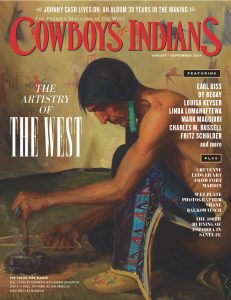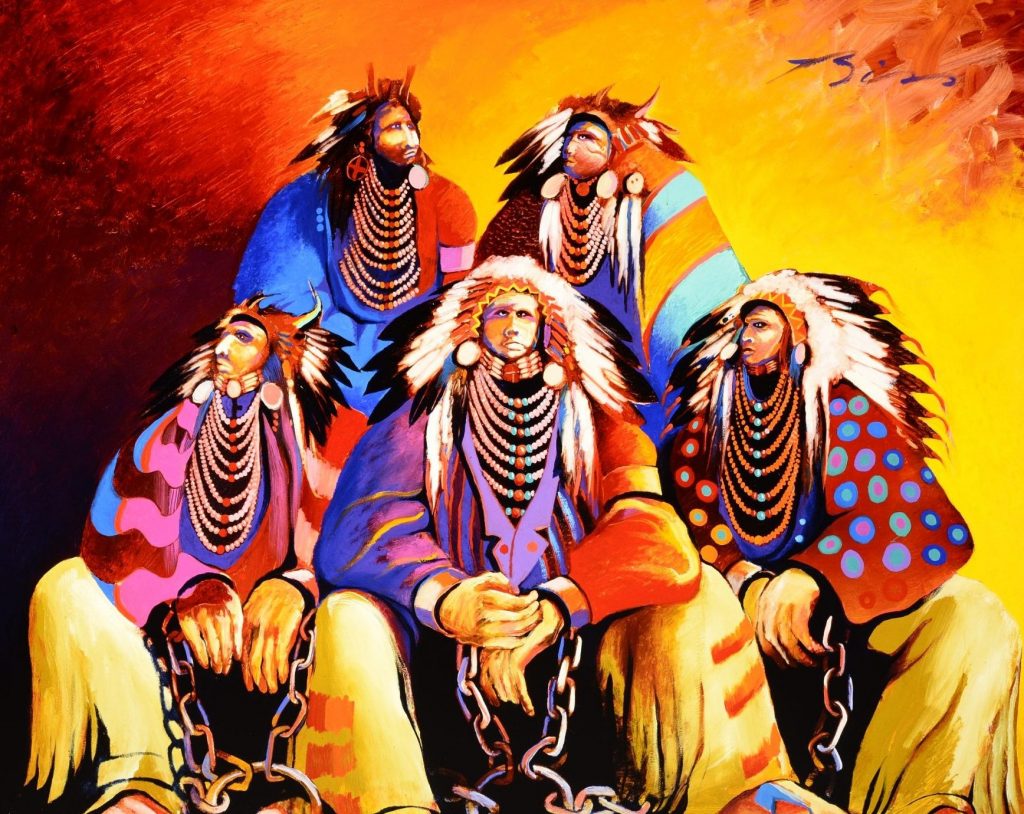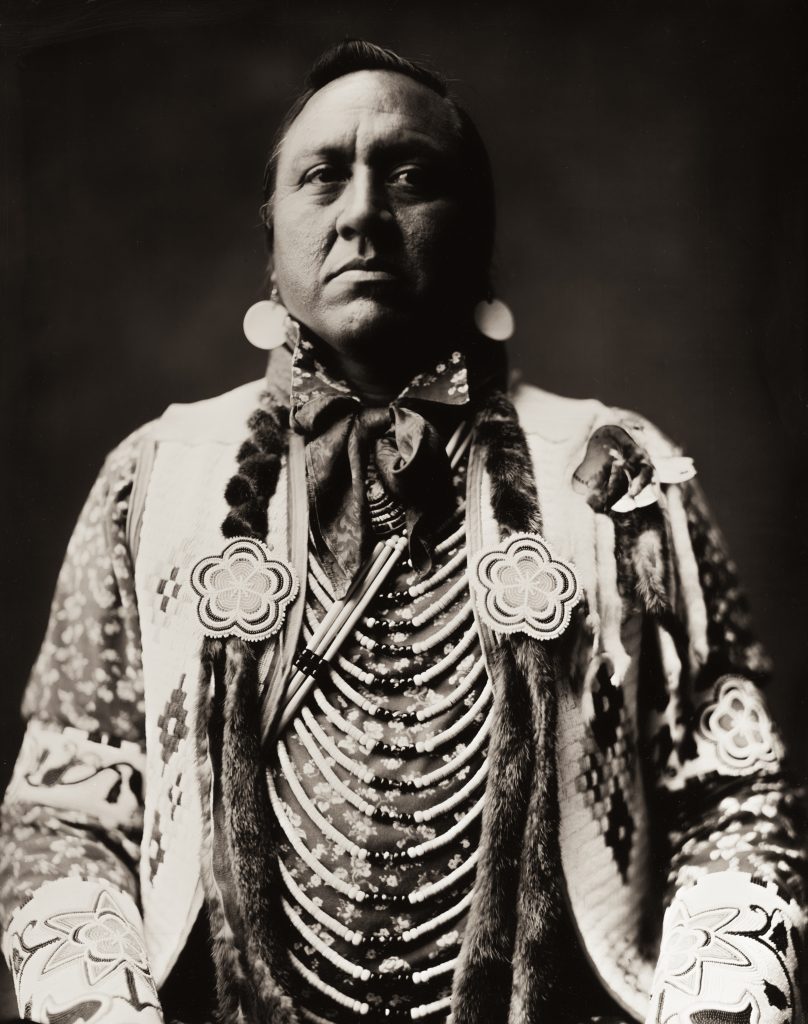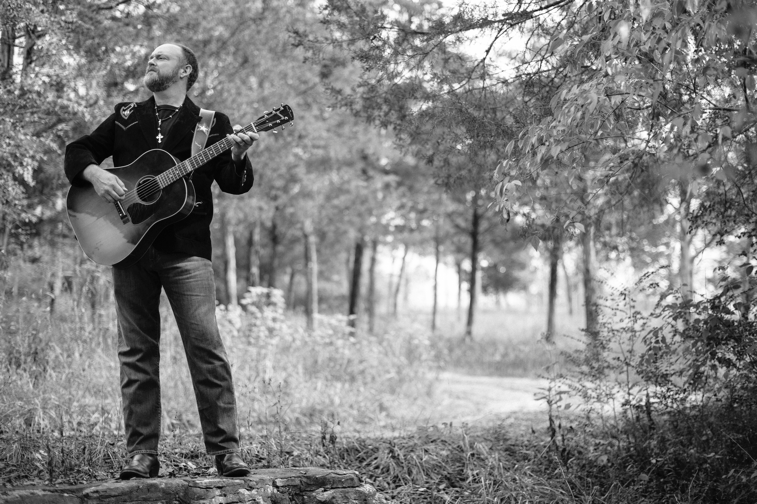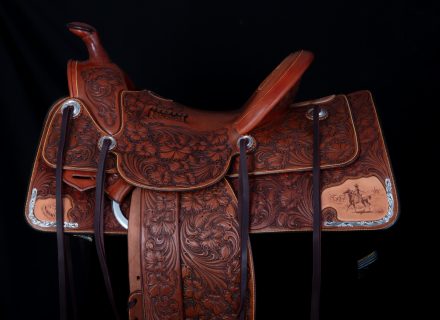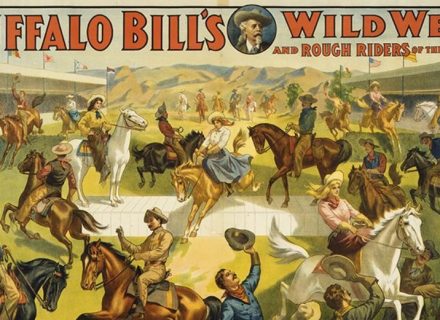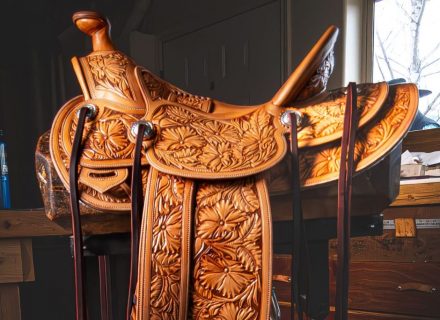Explore groundbreaking Indigenous artists, meet the geniuses behind the breathtaking Dark Winds landscape, and more in our August/September 2024 issue.
“Every child is an artist. The problem is how to remain an artist once we grow up.” Picasso said that, and you don’t have to love his art to agree with his keen observation. If you remember your own childhood and have had or been around little ones, you know. Give kids a crayon and a piece of paper, and off they go.
In our August/September 2024 issue there’s a lot of art to ponder and enjoy, from the transportive wet plate photographs of Shane Balkowitsch to the masterly oils of Apsáalooke painter Earl Biss. But this edition of Cowboys & Indians has much more to explore.
Check out what you might have missed in this issue of C&I and order your own copy here.
Art & Culture
In honor of a piece from their vast collection gracing C&I’s August/September 2024 cover, the Briscoe Western Art Museum chose 12 works in its collection that capture and celebrate the West. Close friends, historians, and artists shed light on the life of Earl Biss, the Crow artist who helped spearhead the contemporary Indigenous art movement. Time slows down to a glacial pace in Shane Balkowitsch’s North Dakota studio as the photographer uses an ancient art form to capture modern Indigenous figures. The origins of Santa Fe’s century-old public art spectacle come to life as historians explore the Burning of Zozobra.
> Read The West Starts Here: 12 Works From The Briscoe Western Art Museum
> Read Earl Biss: The Spirit Who Walks Among His People
> Read Catching Shadows: The Photograph Of Shane Balkowitsch
> Read Burn, Zozobra, Burn
Art galleries and exhibitions showcasing the work of transcendent Western and Indigenous artists abound in this issue. Diné artist DY Begay weaves the colors and traditions of her homeland into her tapestries. Abstract pioneer Linda Lomahaftewa learned from early icons, became renowned herself, then passed it on. Cheyenne and Arapaho warrior artists incarcerated at Fort Marion, Florida, are remembered in an exhibition at the National Cowboy & Western Heritage Museum. A new exhibition at Crystal Bridges Museum of American Art explores how Native American and non-Native art created between 1785 and 1922 coexists and celebrates the diverse West.
> Read Art Gallery: DY Begay
> Read Art Gallery: Linda Lomahaftewa
> Read Art Gallery: Imprisoned But Empowered
> Knowing The West With Crystal Bridges Museum of American Art
Entertainment
After living a full and prosperous tribal life, Chief Dan George took up acting in his 60s and scored a historic Oscar nod for Little Big Man. C&I takes a deeper look into the life of the Native acting legend and recommends a few of his greatest screen performances. Award-winning producer John Carter Cash chats about his new album, Songwriter — a compilation of the uncovered, refreshed recordings of his legendary father.
> Read Chief Dan George. Icon. Oscar Nominee. Native American Groundbreaker.
> Read Behind-The-Scenes Of John Carter Cash New Album
Indigenous Life
The Indigenous ensemble cast of Dark Winds — including standouts Zahn McClarnon, Kiowa Gordon, and Jessica Matten — has rightly been lauded for bringing to life 1970s Navajo Nation as depicted in Tony Hillerman’s classic Leaphorn & Chee novels. But there’s one unassuming character that has appeared in each and every episode of the AMC noir thriller, sometimes even stealing the spotlight from these Native stars: that mesmerizing Southwestern landscape. Thanks to hit shows like Dark Winds, Indigenous-owned Camel Rock Studios is making its mark on Hollywood.
> Read Setting The Scene With Camel Rock Studios
 Zahn McClarnon behind the scenes of Dark Winds (PHOTOGRAPHY: Courtesy AMC).
Zahn McClarnon behind the scenes of Dark Winds (PHOTOGRAPHY: Courtesy AMC).
Food & Drink
Candace Samora waits for the leaves to change each autumn before embarking on her family’s centuries-old tradition of gathering piñon nuts. “My dad’s side is a mix of Hispanic and Pascua Yaqui,” she says. “My mom’s family is Navajo, and she still lives on the reservation where there are groves of piñon trees. The season’s tradition was passed on to me by both of my parents since the piñon is found in Colorado and Utah,” explains Samora. Growing up in the Roaring Fork Valley of Colorado, Samora was surrounded by the piñon tree and its delicacy — the piñon nut, the world’s second most expensive nut, outpriced only by the macadamia. Learn about the history and cultural significance of the piñon nut, stock up on piñon provisions, and try a few piñon recipes.
 Candace Samora holds a bowl of piñon nuts she harvested by hand in the Roaring Fork Valley of Colorado (PHOTOGRAPHY: Julie Bielenberg).
Candace Samora holds a bowl of piñon nuts she harvested by hand in the Roaring Fork Valley of Colorado (PHOTOGRAPHY: Julie Bielenberg).
Home & Ranch
Very few states in the United States have a single definitive architectural style. New Mexico comes close thanks to building hallmarks that are as unique as the landscape. Los Poblanos is a testament to the architectural inspirations of the Land of Enchantment and the lasting power and influence of John Gaw Meem’s design.
> Read Meem Culture With Los Poblanos
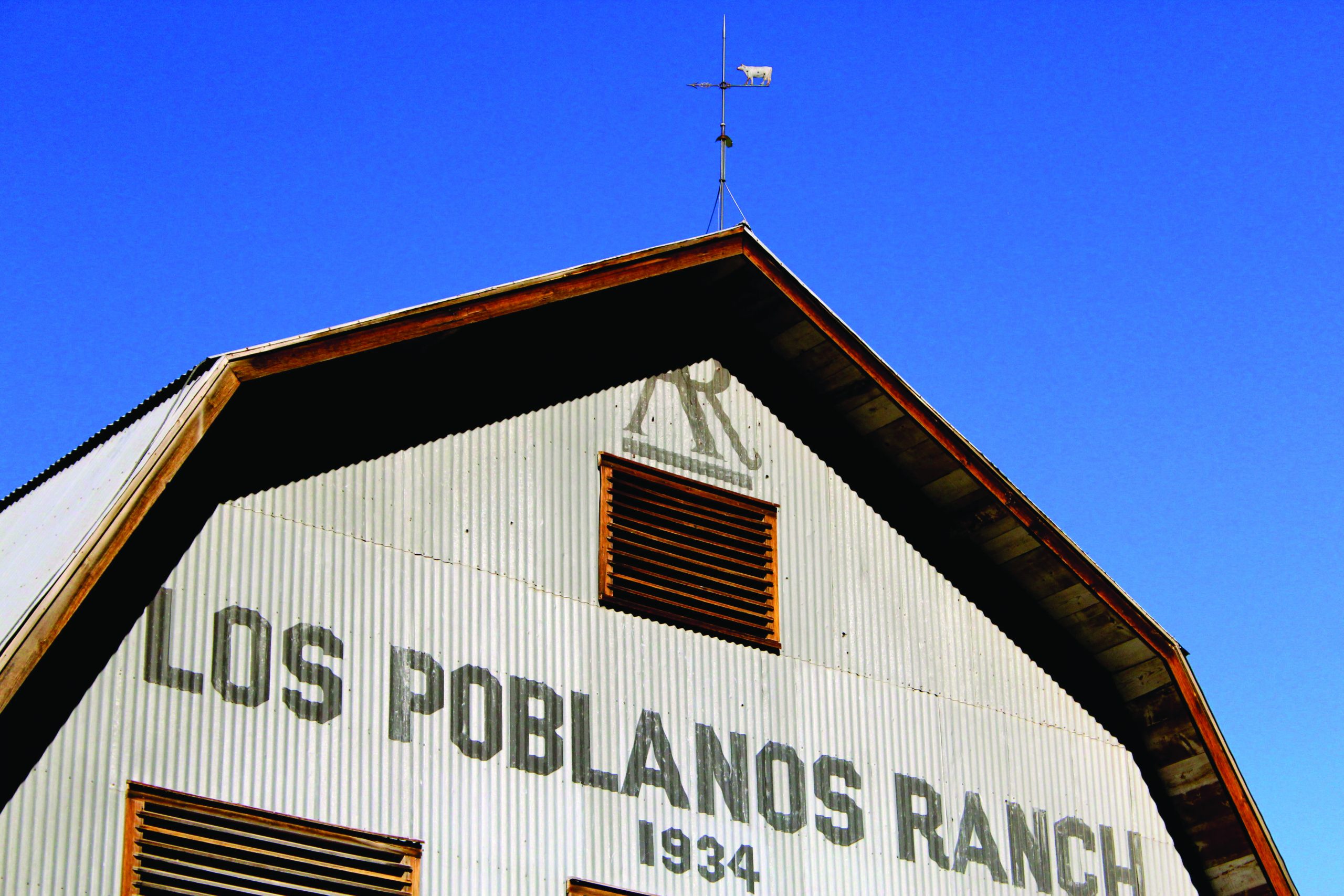 PHOTOGRAPHY: Courtesy of Los Poblanos Historic Inn & Organic Farm
PHOTOGRAPHY: Courtesy of Los Poblanos Historic Inn & Organic Farm
Legends & History
This is a tale of two cowboys — both good guys. The first is Rick O’Shay, the boyish, amiable marshal of a town called Conniption. From 1958 to 1981, the comic strip exploits of Rick, gunslinger Hipshot Percussion, and gambler Deuces Wild appeared daily in the nation’s newspapers. Almost 70 years ago, the marshal of Conniption rode into the nation’s newspapers courtesy of Montana cartoonist Stan Lynde. C&I explores and celebrates the legacy of the comic strip cowboy.
> Read Remembering Rick O’Shay And Cowboy Comic Strip Artist Stan Lynde
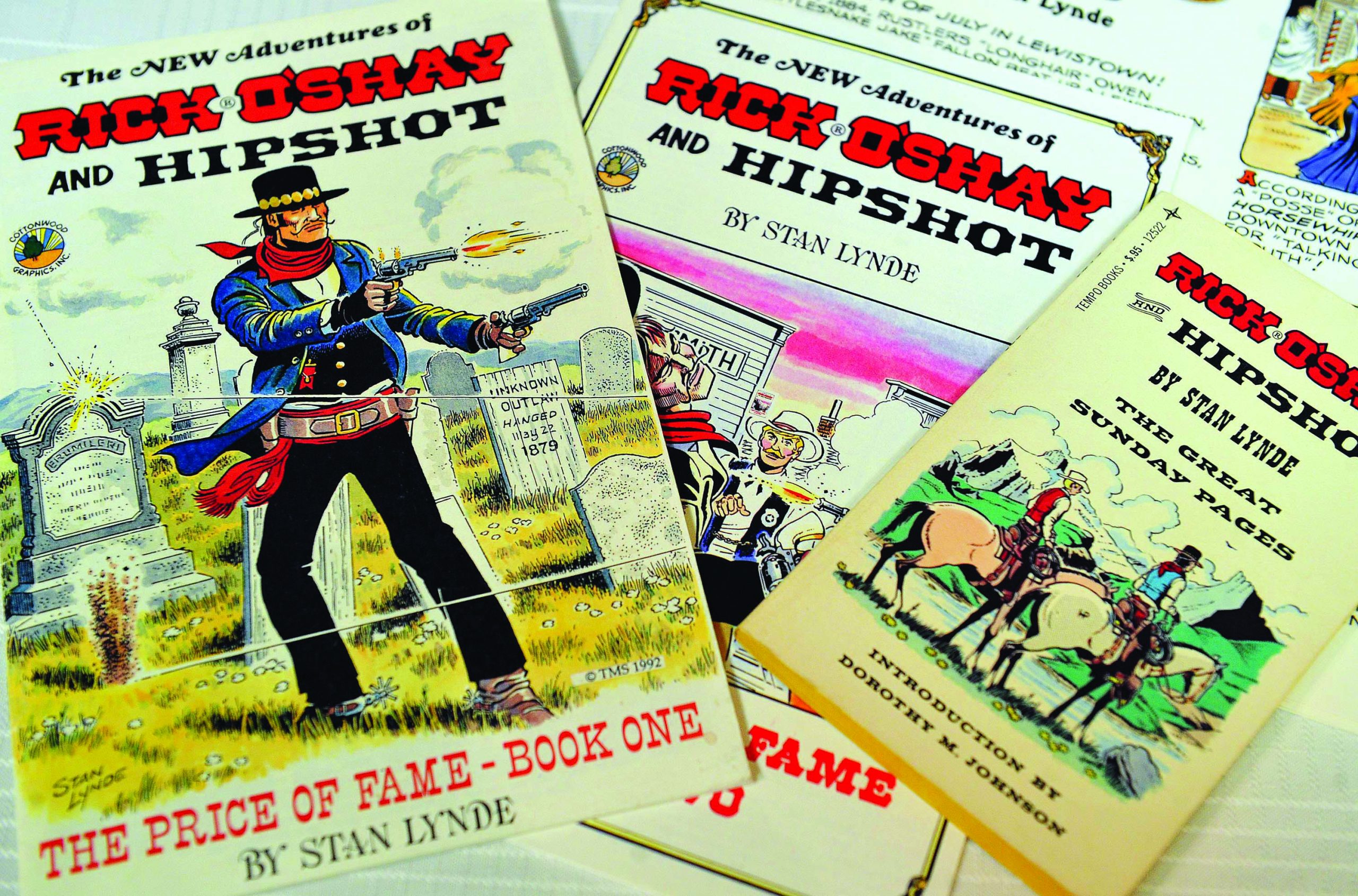 Rick O’Shay, Hipshot, and Me: A Memoir by Stan Lynde includes 10 complete stories from the daily comic strip and an introduction by Charlton Heston (PHOTOGRAPHY: Eliza Wiley/Independent Record).
Rick O’Shay, Hipshot, and Me: A Memoir by Stan Lynde includes 10 complete stories from the daily comic strip and an introduction by Charlton Heston (PHOTOGRAPHY: Eliza Wiley/Independent Record).
Sporting Life
On June 11, 1905, the historic Miller Brothers 101 ranch invited the public to watch the debut of their new Wild West show, billed as “Oklahoma’s Gala Day.” The performance included an appearance by Geronimo (who shot a bison from a car), rodeo events, Native American sports, traditional dances, and a giant parade. The popularity of the inaugural exhibition spurred a decades-long touring show — one that showcased Western entertainment greats of the time: Buffalo Bill, Lillian Smith, Tom Mix, and a talented performer named Bill Pickett. Named for a pioneering cowboy athlete, the Bill Pickett Invitational Rodeo circuit feels more vital than ever after 40 years of sport and education.
> Read The Bill Pickett Invitational Rodeo — An Active Legacy
 Bill Pickett was the inventive Black Cherokee cowboy renowned for his creation of “bulldogging.”
Bill Pickett was the inventive Black Cherokee cowboy renowned for his creation of “bulldogging.”
Travel
Trekking across Wyoming puts you on the tracks of Native American tribes, explorer John Wesley Powell, Old West bandits, and New West adventure. Take a C&I-guided excursion through the historic trails of Wyoming. Whether you’re seeking home-altering décor or simply looking for visual inspiration, the Canyon Road area of Santa Fe is known as an art lovers’ respite. We’d suggest plotting out your day(s) there with a few highlights from our recent visits.
> Read Historic Trails Across Wyoming
> Read Explore The Hidden Gems Of Canyon Road
 The views available on the historic trails of Wyoming are unmatched (PHOTOGRAPHY: Shilo Urban).
The views available on the historic trails of Wyoming are unmatched (PHOTOGRAPHY: Shilo Urban).
Fashion
The energy, excitement, and enthusiasm for SWAIA Native Fashion Week—the first of its kind in the United States—was palpable across Santa Fe. Fashionistas, creatives, and design aficionados from across North America descended upon the New Mexico capital May 2 – 5 for a stylish celebration that officially cemented the Southwest city as the epicenter for Indigenous design. Get the full recap of the historic night and check out the latest trends in Indigenous fashion.
> Read SWAIA Native Fashion Week Hits And Highlights
 Jamie Schulze and Amber-Dawn Bear Robe (PHOTOGRAPHY: Courtesy of Tira Howard).
Jamie Schulze and Amber-Dawn Bear Robe (PHOTOGRAPHY: Courtesy of Tira Howard).
HEADER IMAGE: Martin Grelle (b. 1954), Crooked Lance, 2002, Oil on linen 20 x 20 inches,Gift of the Jack and Valerie Guenther Foundation.







